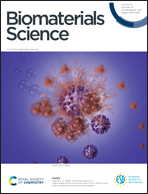Antibody-functionalized theranostic protein nanoparticles for the synergistic deep red fluorescence imaging and multimodal therapy of ovarian cancer†
Abstract
Among women, ovarian cancer is the fifth most frequent type of cancer, and despite benefiting from current standard treatment plans, 90% of patients relapse in the subsequent 18 months and, eventually, perish. As a result, via embracing nanotechnological advancements in the field of medical science, researchers working in the areas of cancer therapy and imaging are looking for the next breakthrough treatment strategy to ensure lower cancer recurrence rates and improved outcomes for patients. Herein, we design a novel phototheranostic agent with optical features in the biological window of the electromagnetic spectrum via encapsulating a newly synthesized phthalocyanine dye within biocompatible protein nanoparticles, allowing the targeted fluorescence imaging and synergistic dual therapy of ovarian cancer. The nanosized agent displays great biocompatibility and enhanced aqueous biostability and photothermal activity, as well as high reactive-oxygen-species generation efficiency. To achieve the active targeting of the desired malignant tissue and suppress the rapid clearance of the photosensitive agent from the peritoneal cavity, the nanoparticles are biofunctionalized with an anti-folate receptor antibody. A2780 ovarian cancer cells are employed to confirm the improved targeting capabilities and the in vitro cytotoxic efficiency of the theranostic nanoparticles after exposure to a 660 nm LED lamp; upon measurement via MTT and flow cytometry assays, a significant 95% decrease in the total number of viable cells is seen. Additionally, the therapeutic performance of our newly designed nanoparticles was evaluated in vivo, via real-time thermal monitoring and histopathological assays, upon the irradiation of tumour-bearing mice with a 660 nm LED lamp (0.05 W cm−2). Foremost, separately from steady-state fluorescence imaging, we found that, via utilizing FLIM investigations, the differences in fluorescence lifetimes of antibody biofunctionalized and non-functionalized nanoparticles can be correlated to different intracellular localization and internalization pathways of the fluorescent agent, which is relevant for the development of a cutting-edge method for the detection of cancer cells that overexpress folate receptors at their surfaces.



 Please wait while we load your content...
Please wait while we load your content...